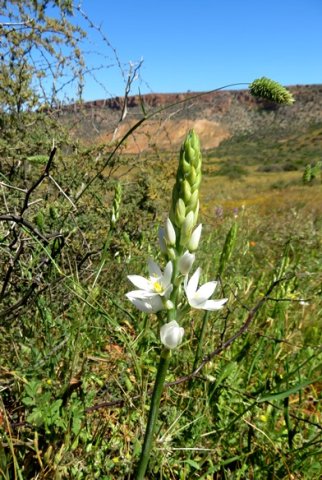Ornithogalum

Author: Ivan Lätti
Photographer: Thabo Maphisa
Ornithogalum is a genus of bulbous, mostly deciduous and few evergreen perennials in the Hyacinthaceae family, commonly known as chincherinchees.
There was a formal name change decision taken in 2016 by the APG (Angiosperm Phylogeny Group) IV, moving Hyacinthaceae entirely into Asparagaceae as the subfamily Scilloideae. This will probably cascade through the botanical literature in due course, meaning that Hyacinthaceae is officially no longer recognized as a separate family. Later South African books do not necessarily show this change yet, for reasons including that it is not legally binding and the people in the plants community are allowed to take their time in absorbing changes, bigger ones more slowly. And, of course, some recent decisions may be expected to be reversed or modified still, as all the evidence supporting them may not yet have fully percolated through the system.
Optional earlier classifications may thus be continued, preventing sudden changes from causing regional confusion among users. Allowing taxonomic conservatism to adapt, should be regarded as temporary, for in the end all recognized plant families should be monophyletic, meaning that they confirm descent from a most recent common ancestor and include all descendants. Formally given scientific plant names are continually brought up to date, in accordance with this principle. This website, mainly serving amateurs, usually follows the SANBI Red List Site in its timing of reflected changes.
Ornithogalum bulbs, usually underground, grow solitary or in colonies. The bulb scales sometimes continue upwards into bulb necks. Bulbils are often formed.
The plants grow one to many leaves, before or concurrent with the flowers. The leaves grow in basal rosettes or in two ranks. They are thread-like to oblong or lanceolate in shape, usually with acutely pointed tips. Leaf margins are smooth, fringed or rough, the blades sometimes hairy. Tubular cataphylls are present in some species.
The inflorescence is mostly a slender or flat-topped raceme on an erect, curved or angled scape. Bracts are present, varying in size. The six-tepalled flowers may spread in a star-shape or curve into a cup- or bell-shape. They are scented, the pedicels varying in length. Flower colours range across green, white, yellow, orange, red or buff, sometimes with a dark centre or a stripe on the outside of each tepal. Tepals are mostly free to the base, in two nearly equal whorls.
There are six stamens in a flower, the anthers turned inwards and the filaments angled outwards. The three-locular ovary is superior, globular or three-angled and sessile or stalked. There is sometimes a cylindrical style present. The stigma varying in size, is sometimes three-lobed.
The fruit is a capsule, sometimes three-angled and ribbed, transparent or leathery. The disc-like seeds vary in size and shape, shiny black and sometimes smooth.
There are about 200 Ornithogalum species occurring in Africa, Europe and western Asia; 70 of them in southern Africa. The habitat is dry to marshy. Many local species are winter-growing and spring-flowering.
The generic name, Ornithogalum, is derived from the Greek words ornis meaning bird, ornith meaning pertaining to birds and gala meaning milk, referring to the Greek notion and expression of bird's milk signifying something beautiful. Some Ornithogalum flowers are also white, maybe adding to the milk allusion. The chincherinchee common name is onomatopoeic, reflecting the sound produced when the plant's stems are drawn across each other.
The plants are well-known in horticulture. Some species are poisonous and cause stock losses.
The plant in picture is Ornithogalum strictum growing in the Biedouw Valley (Pooley, et al, 2025; Euston-Brown and Kruger, 2023; Leistner, (Ed.), 2000; Vlok and Schutte-Vlok, 2015; Manning, 2007; Andrew, 2017; http://redlist.sanbi.org).

